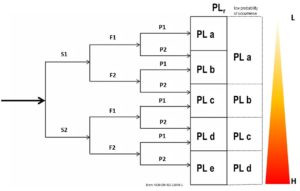Risk analysis is perceived as something difficult, yet we all do it almost daily. In traffic, you (unconsciously) constantly make a risk analysis; is it possible or/and responsible to overtake or cross here now. The consideration of how fast you want/are able to drive is also a consideration of risk factors.
So actually risk analysis is an unconscious daily activity but when someone is asked to do it in a business setting, that person often looks up a bit startled.
The problem lies in the fact that it is frequently unclear what approach is needed. In traffic, everyone knows how to make a risk analysis based on years of experience. In business, that experience is usually lacking, whereas in all kinds of business processes, risk analysis is an excellent tool to support decisions or assumptions.
Consider, for example, Explosion Safety Documents under Atex or Fire Safety Plans because fire safety regulations are also (slowly) becoming more risk-driven.

Illustration:
The riskograph is one of the models used by HSE when conducting a risk analysis.
A risk analysis has a few phases; identifying the hazards and then weighing the risks present. A feature of a risk analysis is that both phases are carried out in a structured manner.
The hazard inventory normally takes place with a number of people who are involved in the business processes from different perspectives, e.g. production or process employees, technical staff, safety officers, etc.
The weighting of factors is done by a safety expert and can be done qualitatively or quantitatively. In a quantitative weighting, a calculation is used to assign a grade to the risk in question, while a qualitative risk assessment is based on the expert judgment of those involved.
There are various models that can be used to carry out a risk analysis, such as Kinney and Wiruth and the riskograph used by HSE-advies B.V. when preparing various RI&Es.
